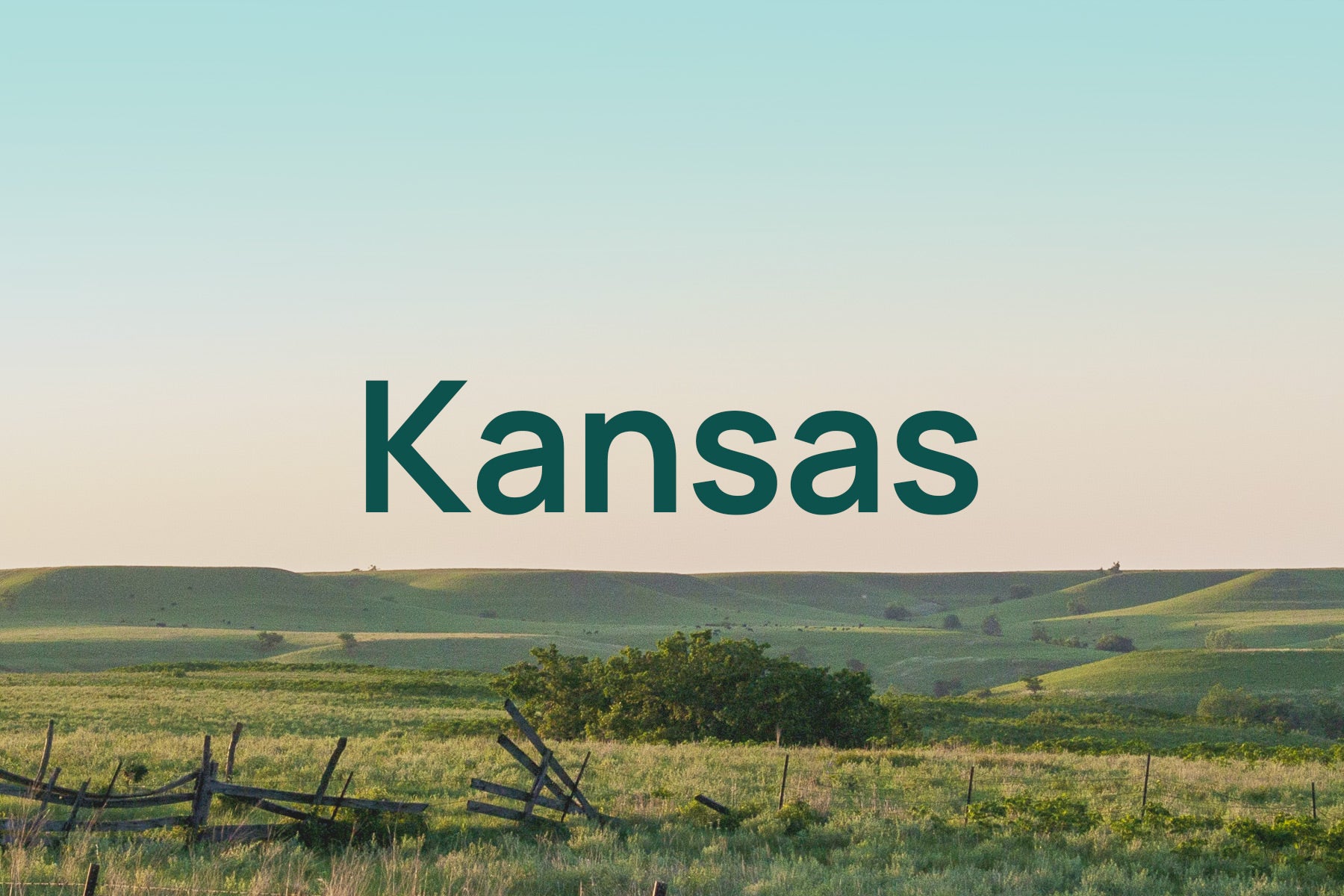Breathe Freely

Is Kansas Allergy Season A Cause For Concern?
Known for its oiling, farming, and sprawling great plains, The Sunflower State is also a potential headache for people with bad allergies. If you’re struggling with Kansas’ allergy seasons, you’re not alone.
Smack dab in the heart of the Midwest, the state of Kansas is home to gorgeous daisy-like flowers, massive cattle populations, and unmatched wheat production. From visitors hiking the luscious Strawberry Hill to longtime residents dipping in Wilson Lake, there are many ways to enjoy the natural beauty of this state, even at the peak of allergy season.
Unfortunately, all of these things can also be problematic for seasonal allergy sufferers. Whether you’re huddled inside in the northwest, or traveling through the flatlands of the High Plains, you should always take seasonal allergies seriously.
Know your forecasts, take proper measures, and consider the role of immunotherapy in symptom prevention and reduction.
Here’s all you should know about the state’s distinct seasons and how you can minimize symptoms.
How Serious Is Kansas Allergy Season?
Like most states, Kansas’ allergy seasons differ in severity and duration depending upon - you guessed it - your own susceptibilities! With the unfortunate distinction of containing ‘the allergy capital of the U.S.,’ Kansas may pose issues even for people who don’t normally experience serious seasonal allergies.
That’s why it’s always a good idea to understand the seasonal fluctuations in allergens, from frosty winter to burning summer. With keen insights into the factors that affect season-by-season allergies, you can effectively treat and even prevent your symptoms.
Are Kansas’ Allergy Seasons Changing?
The average length and severity of the Kansas allergy season has increased noticeably since just thirty years ago. According to some research, typical allergy seasons are now lasting nearly three weeks longer and generating over 20% more pollen than in the 1990s.
If you’re wondering why, the answer is multifold. Climate change is believed to be a major culprit, driving increased tree pollen during Kansas’ spring, grass allergies in the summer, and weed pollen in the fall before the winter chills kill most of these issues. The state’s industrial practices, husbandry, and overall weather patterns may exacerbate seasonal allergies as well.
As with many locations, April, May, June, and September are the main months for most allergy sufferers to be on their A-game.
The Main Causes of Seasonal Symptoms in Kansas
It’s not rocket science to know that pollen is a major irritant for people, with some estimates putting the number at over 80 million Americans with seasonal hay fever. If you’re living in Kansas, you’ll want to take every precaution to minimize your exposure during peak periods.
Are you trying to pinpoint the precise allergy-causing, headache-inducing, day-ruining allergens responsible for your troubles? With environmental allergies growing across the world, now is the time to know your triggers.
Summer Allergy Season in Kansas
With a statewide average of around 77°F, Kansas summers are certainly not unbearable, but that doesn’t mean you aren’t going to be inundated with pollen! As the grass species kick up and those Tornado Alley winds spread their grains, you could be looking at some serious sneezing, coughing, and itching. Try to limit your exposure to rye, Kentucky bluegrass, and orchard grass species especially.
Kansas’ Fall Allergy Season
The trees are changing and there’s a crispness to the air, signaling the end of heat and gradual descent into cooler temps. With average temps of ~70°F, 60°F, and 45°F in September, October, and November, the autumn period is a nice time to admire the changing leaves, go hiking, and attend festivals. Just be wary. Weed pollen becomes prominent during these months, marked by ragweed, sagebrush, and mugwort.
Wintertime Allergies in Kansas
Although Kansas is known for milder winters, don’t be surprised by the occasional arctic blast! The biting wind can also make it feel colder than it is. With January the coldest month of the winter, averaging right around freezing (31°F), you can finally stop worrying about pollen. However, now you have to think about the indoors. Common environmental allergens like dust mites, cockroaches, mold, and dander from your pets can be readily spread by circulating hot air, exacerbating scratchy throats, skin issues, and respiratory distress.
Kansas Allergy Season in Spring
As frosty conditions begin to thaw from February into March, the dormant trees once more come alive, and with them, the threat of tree pollen allergies. Like with many midwest states, you’ll need to be wary of cedars, maples, and ash trees in particular. With average temps relatively cool at ~45°F in March, you can expect a nice warmup to 66°F in May. It’s the perfect time for a brisk morning walk through windswept meadows - assuming the pollen counts are low!
What Makes Kansas’s Allergy Seasons So Distinct?
Kansas presents unique situations for allergy sufferers for various reasons. Firstly, the state itself is actually located in three climatologically diverse regions. The Northern Great Plains, Southern Great Plains, and Midwest Mississippi Valley regions all contain unique species of plants, undergo shifting weather patterns, and contribute to Kansas’ seasonal allergies differently.
For instance, springtime allergies in Wichita and Great Bend usually stem from willows, oaks, walnuts, and hickory trees, while typical allergenic grasses include bermuda and fescue varieties. By comparison, tree allergies around the Kansas City area stem from similar species, but the grass allergies usually come from timothy and bent species. Meanwhile, weed allergies near Garden City and Dodge City may be caused by orache, which is not common in other regions.
Overall, these variations, combined with the state’s notable winds, farming industry, and floral sprawls, can make Kansas allergy season a serious issue for some people. Unfortunately, Kansas’ unique precipitation patterns may also add to these allergenic triggers.
How Rain Impacts Seasonal Allergies in Kansas
As it turns out, the role of rain in Kansas’ seasonal allergies may be significant. When it comes to rainfall and allergies, there is often a misconception. Many people assume that rain drowns pollen out, dropping it from the air and thereby lessening allergy symptoms. Although this is true, initially, the allergenic effects of downpours are both short-term and long-term.
Precipitation’s Role in Kansas Allergy Season
Depending on the frequency and severity of the rainfall, plants will absorb vital micronutrients and actually begin to grow even more. This, in turn, triggers more pollen release in the future. In the short term, heavy downpours also help release pollen into the air once the precipitation ceases. This happens because larger pollen accumulations get broken up by the rain, causing smaller grains to go airborne. This is especially true of pollen from weeds and grasses, which tend to clump until they are released into tinier particles.
During Kansas allergy season, you also have to worry about accompanying winds which further exacerbate this process. With some torrential downpours, you may experience water in your home, causing the buildup of mold as well.
Precipitation Amounts Vary Widely Across Kansas
According to researchers at Kansas State University, rainfall in Kansas varies significantly along an East-West gradient. In other words, the further west you go in Kansas, the less precipitation from rainfall you can expect. In southwest Kansas, you may get only 13” of annual rainfall, whereas southeast Kansas can see close to 50 inches!
Snowfall is the opposite, with a Northwest-Southeast gradient. In some parts of northwest Kansas, you can see up to 40” of annual snowfall. In the deep southeast regions, you may barely receive a dusting at 2” of yearly snow.
Given these climate, precipitation, and temperature variations, it’s no wonder Kansas can be a problem for certain allergy sufferers!
Putting Kansas Allergy Season Into Perspective
From rain-borne mold, windswept pollen-rich meadows, and other dust, dander, and environmental triggers, the Sunflower State can be as burdensome as it is beautiful.
A recent report from the nonprofit Asthma and Allergy Foundation of America found Kansas’ most populated city, Wichita, to be the worst city in the country for allergies. This unfortunate distinction was based on three categories. The Foundation rated Wichita as having “worse-than-average” tree and grass pollen, “higher-than-average” needs for allergy medication, and a diminished prevalence of certified allergy specialists.
Although the issues in Wichita are often chalked up to the native plant species - especially maple, cedar, and elm trees - many experts also contend that the strong winds, wildfire smoke, and lack of reliable cover crops make the air dusty, thick, and highly allergenic.
So, if you’re suffering from bad allergies in Kansas, from Wichita to Belleville to anywhere else, you need a treatment plan that works.
Best Ways to Manage Seasonal Allergies in Kansas
You’ve probably heard many of these before, but they bear repeating. While you can always run to the pharmacy or convenience store for some cheap medication, this is only a temporary fix. One of the first steps you should take is minimizing your exposure to allergens that trigger your symptoms.
Not sure what exactly is triggering your allergies?
Try the following tips and strategies to reduce symptoms and pinpoint your particular problem.
Examine Your Indoor Spaces
Think about all the places and areas you frequent. This may include your home, workplace, vehicle, and other spots where you spend time, such as restaurants, offices, facilities, and other hangouts. What are these places like? Are they well-ventilated? Are they in locations that are exposed to pollen, with open windows, heavy vegetation, or windy settings?
When do you visit these areas? During the fall, spring, or summer? Do you like to get warm and cozy near a fireplace when it’s cold?
Now think of when your symptoms start acting up. What are you doing? Where are you? What is the indoor environment like? Depending upon your setting, you may be exposed to dust, pollen-heavy rooms, or damp, moldy interior walls that you can’t even see. Consider the possibilities, and note when your allergic reactions peak and lessen. As always, follow local forecasts for pollen counts and consult leading allergy specialists for help.
Clean and Maintain Indoor Spaces
Once you’ve adequately inspected your indoor areas, it’s time to go to work! It’s recommended that you perform regular cleaning around your home. Clean up pet dander and dust, wash bed sheets and linens, wipe down furniture, and look for rodents and pests. Set traps if need be, put food away in your pantry, and mop up any spills.
Mold loves to fester behind walls, so if you’re feeling allergic flare-ups but your place is otherwise spotless, it might be a good idea to call a remediation technician. At the very least, change your air filters every few months. The best thing to use is a high-efficiency particulate air (HEPA) filter. This can help pull dangerous mold spores from the air while keeping clean air circulating.
Also, don’t forget your car. Wash it out with some leather and carpet cleaner, a nice scrubbing brush, and some disinfectant wipes. Clean out garbage and dirt, and take your vehicle for a car wash if pollen is accumulating on the outside.
Shower and Change Clothes Regularly
This one is simple. Whether you’re exposed to horse dander or sagebrush, cockroaches or dust mites, you’ll want to ensure your clothes aren’t carrying allergens. If you work outdoors during Kansas allergy season or simply like to enjoy the state’s beautiful nature, you’ll definitely want to heed this advice.
Wash your hands, face, and hair repeatedly, and change clothes when you can, especially when you feel allergies coming on.
Unless you absolutely have to be outdoors, you should stay inside with the windows closed on high pollen days. If you’re running your furnace or fireplace during the winter, remember that this can cause respiratory and skin irritation if dust, dander, and mold are circulating. If you’re feeling dried out from all that indoor heat, consider a moisturizing lotion or reducing heat usage.
Skip OTC Meds and Try Immunotherapy
If you’re an allergy sufferer, you’re probably all too familiar with medicines like Allegra, Zyrtec, and Claritin. Perhaps you find yourself popping pills, consuming liquids, and even puffing inhalers when peak Kansas allergy season rolls around.
But if you’re looking for a treatment that is easy, lasting, and potentially far more effective, you have to try immunotherapy.
Immunotherapy is a tailored approach to your immune system that targets the exact allergens bothering you. Through immunotherapy, you essentially ‘train’ your immune system to stop over-responding to things like pollen, mold, dust, and other environmental triggers. Immunotherapy is a treatment that can work for life.
Get to The Bottom of Your Allergies
By analyzing a small sample of your blood, we determine which antibodies your body releases to battle pesky invaders. From there, we can determine the exact allergens, or antigens, causing your symptoms.
Your personalized drop formulation is designed only for you, meaning your immune system gets exactly the support it needs.
If you’d like to begin the process, you can start by ordering a FREE at-home allergy test. With this kit, you can provide a sample in just minutes, and be well on your way to receiving your drops.
**Note: While some research indicates the efficacy of allergy drops, every person is different. Sublingual immunotherapy does not work for everyone. You should only use allergy drops under medical supervision.
FAQ
Is Kansas A Tough State For Allergies?
This all depends on the metrics you use. What we do know is that Wichita, Kansas, routinely ranks as the worst or among the worst cities in the U.S. for allergy sufferers. However, the severity of the allergy season will depend on many factors. Your immune system vulnerabilities, changing climate patterns, and exposure risks all mediate the severity of the season.
How Does Allergy Drop Immunotherapy Work?
It’s easy! You simply take daily drops under your tongue, and we ship you updated formulations as you go. Remember, every formulation is tailored to the specific antibodies and antigens impacting your immune system, so you get precisely what you need.
How Long Does It Take To Feel Better?
Most patients report feeling symptom improvement in just weeks to a couple of months. However, we’ve seen many patients report having ZERO symptoms after years on our daily drops. If you have any questions or concerns, feel free to contact us!
Overcome your allergies at home with our doctor-led therapy.
Get started with our free allergy test kitGet Started with no test needed.
Overcome your allergies at home with our doctor-led therapy.
Get started with our free allergy test kitGet Started with no test needed.




